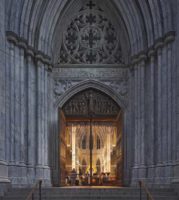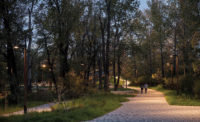On a recent tour of the newly restored St. Patrick’s Cathedral, architect Jeffrey Murphy spoke over an unlikely chorus: hammers nailing pews back into place, persistent drilling on the terrace, and the slow drone of an organ being tuned. With Pope Francis slated to lead evening prayer at St. Patrick’s on September 24, the cathedral is in full preparation mode. It is also wrapping up a multiphase, $177 million conservation project led by New York-based Murphy Burnham & Buttrick Architects (MBB).
When MBB initiated a master plan in 2006, the landmark Neo-Gothic cathedral in midtown Manhattan was in need of immediate repair. Chunks of stone were falling off the building’s exterior, necessitating a full scaffolding of the structure, inside and out.
But the firm also had a long-term vision: reviving the pristine, light-filled space that architect James Renwick Jr. brought to New York in 1879; realigning the cathedral’s architecture with its cultural mission; and setting the building systems on a more sustainable path. They coordinated a team of about 150 restoration specialists and 20 consulting firms to make it happen.
MBB’s first step was to clean the cathedral’s marble exterior—clad in a mix of regional Georgia, Tuckahoe, Cockeysville, and Lee marbles on specific parts of the structure—“not for cosmetic reasons, but to actually reveal the damage to the building,” Murphy said. Using a micro-abrasive cleaning system of water and crushed glass called the Rotec Vortex, they scrubbed years of pollution off the marble that clads the brick piers.
Because the joints between the stones were repaired with cement in the 1970s, which cured grayer than the marble and in some cases cracked the stone, the architects replaced it with the original 19th-century mortar mix, which better matches the stone’s color and texture. “It was intended to look like a single object,” Murphy says. “And now it does; you don’t see the individual stones like you did before.” The effect, he said, makes the cathedral seem “as if it was poured into a mold and tipped over.”
The interior of the building was equally dingy from years of candle soot and air pollution. Workers erected enough scaffolding on the nave and triforium to reach every interior surface, repairing the ceiling, walls, and windows from west to east. They also restored skylights that had been covered with roofing for decades.
In the 19th century, Renwick took a cost-efficient approach to crafting the ceiling, laying cream-tinted plaster onto wood lath ribs to mimic actual stone. Building Conservation Associates, the firm that led the ceiling restoration efforts, cleaned the ceiling (it had turned army green with age) and layered it with three tints of beige paint, preserving Renwick’s intention. In addition to the cosmetic work on the timber ceiling, the restoration team installed a state-of-the-art misting system to mitigate the risk of widespread fire, while minimizing potential water damage to the building.
MBB also coordinated the restoration of more than 3,000 stained glass panels. Restoration consultant Drew Anderson, who oversees the Metropolitan Museum of Art’s stained glass collection, found most of the panels to be in good condition, so the architects took a fairly conservative approach their restoration. “The putty that holds the panels in place was very hard, so taking a panel out would be highly destructive,” Murphy explained.
As a result, the team shipped only 5 percent of the glass to the Indiana for intensive repairs by Botti Studios, a leading glass conservationist. The remainder was restored in situ. In addition to restoring the glass itself, they applied a layer of protective glazing to the exterior of the glass to cut down on UV ray damage. Teaming up with structural engineers Robert Silman Associates, the architects vented the bottom of each window, allowing for air to circulate on both sides of the glass to prevent condensation.
St. Patrick’s restoration went well beyond the cathedral’s surface: by next summer, the building will have a ten-well geothermal plant on site for heating and cooling, a system that will enable St. Patrick’s to save about 30 percent on energy consumption.
Although the project was put on hold during the recession, which hit just after the design phase wrapped up, “The recession enabled us to be incredibly introspective about each and every one of these decisions, because we had time to deliberate,” Murphy said.
A final touch of the project will be to install sliding glass doors at the front of the cathedral. These will serve as a functional addition to the existing bronze front doors, which weigh 9,200 pounds each and were restored this summer by G & L Popian, Inc. “The whole idea is to have a transparent front, so even when it’s five degrees out, we can still have the doors open,” Murphy said. To the design team, this is emblematic of the restoration’s greater aim: to make the cathedral more welcoming to all.
This ethic of transparency and accessibility drove St. Patrick’s to continue to hold mass seven times a day throughout the restoration.
“The priests learned to talk louder so people could hear their sermons,” Reverend Monsignor Robert T. Ritchie, the church’s Rector, said. “We’re almost finished now, so we’ll have quiet masses.”
Quiet, that is, “after the Pope is here.”
















